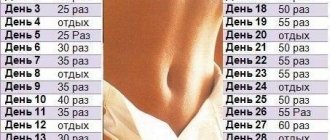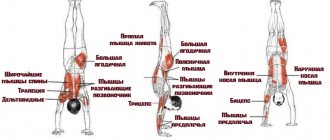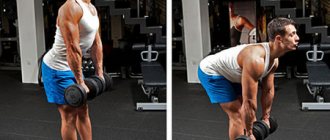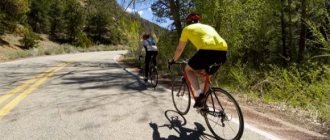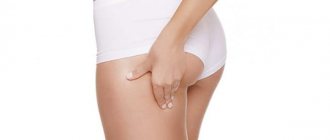What exercises to do to pump up your lower legs?
There are many exercises for working out the lower leg, more details in the main article: “Exercises for the lower leg,” however, in fact, only TWO MAIN BEST EXERCISES can be distinguished:
- Standing calf raise
- Seated calf raise
Learn more about the technique of performing these exercises: “Standing calf raise” / “Seated calf raise.”
There is no point in comparing these exercises with each other, because... when performing them, different muscles are worked out. In the first exercise (standing calf raises), the CALVES work with emphasis. In the second exercise (seated calf raise), the SOLEUS MUSCLE works with emphasis.
THE SOLEUS MUSCLE is located UNDER THE CALF. This muscle seems to push the CALF OUT (due to this it looks more massive). Do you understand?
This is why both the CALVES and the SOLEUS MUSCLES are extremely important. Developing one thing while neglecting the other is absolutely not possible. It's simple: CALVES without soleus will not look as massive as they could look, and vice versa.
CONCLUSION: standing calf raises (or its variations) + sitting calf raises (or its variations) = mandatory exercises in the program, which cannot be neglected or concentrated on one thing, otherwise you will not see truly massive calf muscles - NEVER ! ! ! In other words, it is extremely important to work both the CALF and SOLEUS!
What to do if the calf muscles do not grow
Sometimes athletes practice, following all the rules, but there is no progress. This may be due to the fact that the list of exercises they use is limited. In order for a woman or a man to quickly pump up their muscles, they need to combine elements in a standing and sitting position. When an athlete does an exercise while standing, the calf muscle tenses; if he sits down, the load shifts to the soleus.
If the muscles do not increase, then try to increase the range of motion. Raise your toes as high as possible, and then lower your heel below the horizontal line. Additional weight will only enhance the effectiveness of the exercise.
Calves contain fast and slow fibers, for which you need to choose different training options. To do this, combine heavy approaches with lighter ones.
The calf muscles recover faster than the large ones. Therefore, they need to be trained more often. 1-2 days of rest will be enough. But give up training if muscle pain has not yet gone away.
How many reps should you do for calf exercises?
For those who are not aware of the lower leg, you need to train in a large number of repetitions (from 15-30 per approach, there are no clear numbers, because it’s an individual matter - it’s different for everyone). So, why exactly is this?
The secret is simple! No matter how many reps you do, the MOST IMPORTANT THING IS THE TIME UNDER LOAD, and the time under load should be 10-30 seconds, and this is the time interval you should reach muscle failure.
Typically, for the vast majority of exercises in bodybuilding during this interval (10-30 seconds), muscle failure occurs in the range of 6-12 repetitions per approach (which is why I recommend doing so many repetitions everywhere), but the calf muscles, i.e. SHINS = EXCEPTION. This exercise will require more than 12 repetitions, maybe 20 or even 30 repetitions, because in this exercise the range of motion is very small (short), unlike conventional exercises.
Well, COMPARE (contrast) the AMPLITUDES OF MOVEMENT in the exercises BICEPS RAISES and standing calf raises. Do you understand what a mess this is? In the first case (biceps) you have a huge range of motion (bend and straighten your arm at the elbow joint), but in the second case what? .. => it is very short (rise on your toes and lower), i.e. short range of motion... that’s the whole secret of an increased number of repetitions for training the calf muscles (lower leg).
Those. in most exercises, we usually manage to get muscle failure within 10-30 seconds by performing 6-12 repetitions, BUT here (in training the legs), because the amplitude is very short, we don’t have time to get muscle failure in 6-12 repetitions, and we perform more: about 15-30 (it’s different for everyone).
Exercises to pump up the calf muscles in the gym
- Building muscle in the gymBarbell exercise. Place a barbell with a small weight (10-15 kg) on your shoulders. We rise on our toes as many times as possible. Another option for this exercise is to step 5-10 cm in height and lift from there onto your toes. This significantly increases the load, but also increases the risk of injury.
- While sitting on the floor, the resistance band or resistance band is secured to the arch of the foot. Using springy movements, we pull the foot towards ourselves until a characteristic slight pain in the muscles occurs.
- The step platform is a very effective exercise not only for pumping up calf muscles and losing weight. This is a rhythmic workout that acts as a cardio simulator and provides dynamic strength training. When climbing onto the platform, the muscles of the front thigh (quadriceps) tense. When straightening the leg on the platform, all the muscles of the lower limb are activated. Step training is contraindicated for people with exacerbation of chronic diseases of the joints of the lower extremities and with vascular diseases (varicose veins, thrombophlebitis of the lower extremities).
- Lunges with dumbbells. Starting position: legs together. On the count of “one”, step forward. On the count of “two”, bend the back leg until the knee joint touches the surface of the floor. On the count of three, return to the starting position.
Exercises for the calf muscles are not quite complicated, but their implementation requires some rules:
- Be sure to warm up before exercise.
- Training should take place in sports shoes and clothing.
- The floor surface is flat.
- During training, you must carefully perform all movements so as not to accidentally injure yourself.
Some tips for working on the appearance of any muscles:
- To increase muscle volume and gain mass, you need to do short power movements with light weight and load. Read also: How to pump up arm muscles.
- To reduce the volume, it is necessary to carefully stretch the lower leg after cardio exercise on an exercise bike or running over a long distance.
- To improve the relief, you need to do long repetitions with light weights.
Exercising in the morning on an empty stomach perfectly tones and gives strength for the whole day. For your morning workout, you can choose several light exercises from the above.
How many sets of calf exercises should you do?
Typically, in all exercises (the lower leg is no exception), it is recommended to perform 3-4 WORKING APPROACHES (warm-up, lead-up does not count). However, the question is actually an individual one, because largely depends on your length of service (experience, training). By the way, more experienced athletes can do 5-6 work sessions. More details in the main article: “How many approaches to do the exercises.”
For example, I do 4 jobs. But, because I work according to the pyramid principle (from small weights to large ones, I perform about 7 approaches, which do not count, because they are warm-up / lead-in). Sometimes I also work from small weights to large ones and back to small ones (usually only in the first exercise), you know, a lot of approaches for 1 exercise. Therefore, THE QUESTION IS INDIVIDUAL. I can’t say for sure, the guideline for you is 3-4 WORKERS!
TOP 8 exercises to properly pump up your calves
It is recommended to conduct training no earlier than an hour after eating. The best helper at home will be a rhythmic melody or a sports video.
We rise on tiptoes
This is a simple exercise that physically unprepared women need to master first of all. It can be done on a flat floor, but to increase the range of movements it is better to use any support that can be found at home, such as a door threshold. Stand so that your heel extends beyond the edge of the support.
With dumbbells in your hands, rise up on your toes, then slowly lower onto your feet. In this position, the outer side of the calf muscle is primarily used. To deeply work all areas of the calf, do raises with pointed or pointed toes.
A complicated position is to rise on only one leg, changing them alternately. This technique will significantly pump up your calves even without weights. If you feel intense pain in your foot while lifting, try standing on a flat surface. Pain may be associated with flat feet.
Raise your knees from a sitting position
For this exercise at home, a regular chair will do. If you have a fitball at home, you can use it as a support. Sit down and place your hands with dumbbells on your knees. Lift your heels off the floor and hold this position for a few seconds, then return your feet to the floor.
Squat on your toes
If with the help of traditional squats you can pump up your thighs, then by squatting on your toes we can pump up your calves perfectly. Try to maintain balance by moving your pelvis back. If squatting with dumbbells is difficult, simply extend your arms forward as you lift.
The basic rule for pumping up your calves! If your goal is to reduce the size of the calf muscles, you need to do the maximum number of repetitions with light weights. This technique is used by athletes to “shrink” muscle mass. If your goal is to build athletic calves, perform fewer reps with heavier weights.
We walk on our toes
This fun action can not only be included in your home complex, but also adopted in everyday life. Stand up on your toes and slowly walk around the house, holding dumbbells in your hands. At the same time, try not to bend your knees.
Jump up
An excellent workout that allows you not only to pump up your calves, but also to lose unnecessary pounds. When performed regularly, it is productive even without using dumbbells. Just squat down and jump up. Take your starting position standing. Repeat 10-20 times. Instead of dumbbells, you can use weighted cuffs that are tightly attached to the lower leg.
We walk up the stairs
Any staircase is suitable for this exercise, including the stairwell of a residential building. Grab the appropriate dumbbells, go downstairs, and walk up the stairs on your toes. Perform the exercise in one set until you get tired.
"Pistol"
This exercise, familiar from childhood, also does not require heavy weights. Hold a dumbbell in one hand and lean on a chair or furniture ledge. Squat with your leg extended forward. Then change your working leg and transfer the dumbbell to your other hand.
Jump rope
Jumping rope is an excellent workout for the heart and calves in particular. And if you jump on your toes, it instantly turns into an isolated load on the calf muscles. A well-deserved bonus is gaining stamina. This does not count the hundreds of calories that are burned along the way. By the way, the jump rope is a favorite item for toning the calves of boxers and gymnasts. You need to jump until you feel tension or burning in your legs.
How much rest between calf sets?
Everything is also individual. Those. it also depends on how you train your shins... By the way, rest between WORKING approaches in training your shins is no different from training other muscle groups. Those. standard: 1 minute, maximum 2 - no more. Read more in the article: “Rest between sets.”
However, for example, after working approaches I like to do DROP SETS (well, sets with weight loss, a typical striptease, but not what you thought.), and here the rest between such approaches should either not be at all, or very very small (well, 10-15 seconds). I say this to make you understand the point... the question is individual and largely depends on how you train.
Genetics
There are two main types of muscle fibers:
- Slow fibers. They have lower growth and strength potential, but are resistant to fatigue.
- Fast fibers. They have a much higher potential for growth and strength output, but they tire quickly.
Research shows that the muscle fiber composition of the gastrocnemius muscle can vary significantly from person to person. For example, some people have 60% fast-twitch fibers, while others have only 15%. People in the first group will find it easy to add mass to their muscles (they may not even need to worry about a separate calf workout), while people in the second group will not be able to quickly build up their calves and will have to fight tooth and nail for every millimeter. progress. However, do not despair: with proper nutrition and training, anyone can achieve results. Some just take longer than others.
Below are 12 basic exercises for the calf muscles at home and in the gym.
Training program for pumping up your legs
There is no special supernatural (din/sam - hi.) program for FAST GROWTH of calf muscles (calf muscles)! No matter who tells you what)).
If you don’t want to SPECIALIZE (emphasis) on CALVES, then just do the two exercises that I gave you AT THE BEGINNING OF THE TRAINING on leg day (usually they are trained on this day).
Why at the beginning?
Because, as practice shows, at the end of a calf workout, you can no longer train your calves with maximum impact. Just imagine, you did squats, did leg presses, did seated leg extensions, all this for example (a very typical leg workout for people). By that time your quads are already trembling, you can barely stand on your feet at all, and you still need to do some calf work...
Do you understand? It is very difficult to train your calves at the end of a full leg workout. Therefore, first is the time. In addition, many people are lazy at the end (at the end of the workout) to train their calves, and thus neglect them with such an attitude - you won’t see voluminous calves...
If you want to SPECIALIZE (emphasis) on CAVIAR, then here’s what the scheme might look like:
Monday (hard calf training, progressive load and muscle failure, CALVES ONLY):
- Standing calf raise
- Seated calf raise
- Donkey
- Toe press on a leg press machine
Friday (light calf training, no progression of load or muscle failure, and the rest as scheduled)
- Standing calf raise
- Seated calf raise
- ...what is on schedule in your training program (for example, HANDS)
However, this is again all purely individual. An example has been given, I hope everything is clear.
Rules for strengthening the lower leg without training
A woman and a man will be able to quickly pump up their calf muscles by following these rules in everyday life:
- Watch your gait. Steps should be wide. Lower your foot onto your toes, smoothly rolling onto your heel. Train yourself to walk 10,000 steps a day.
- Choose comfortable shoes that do not squeeze your toes and allow your skin to breathe. It is advisable to choose models with orthopedic insoles that support the foot.
- Avoid elevators and take steps.
- Try to go barefoot whenever possible.
- If you have a sedentary job, then periodically arrange a sports minute on non-training days.
Try to spend your leisure time actively: walking, cycling, playing team sports. Get enough sleep, eat right. These healthy habits will improve your health and strengthen your muscles throughout your body (including your calves).
General recommendations
Remember to regularly train any muscles, not just calves
- Before doing a set of exercises to develop your calves, be sure to stretch the joints of your ankles and fingers and warm up the muscles themselves.
- After exercise, be sure to stretch your calf muscles. To do this, take a wide step back, placing your heel on the floor and leaning your body forward. Stretch for 10-20 seconds with each leg.
- The range of motion when performing exercises should be maximum.
- The load needs to be changed. Vary the exercises and load, otherwise addiction will occur, which will reduce the effect of the exercises.
- You need to train your calves two or three times a week, giving the muscles time to recover.
- Aerobics should be done at the beginning of the workout, and strength training on the calves should be completed. This is the only way to achieve calf growth.
- If you transfer weight to your thumbs when lifting, the load on the muscles will be better.
- To further complicate the exercises and pump up men's calves, hold for five counts at the top of the lift.
- When pumping up your calves, the main thing is not to overdo it and not overwork the muscles, otherwise you can bring yourself to cramps. And this is at least unpleasant.


